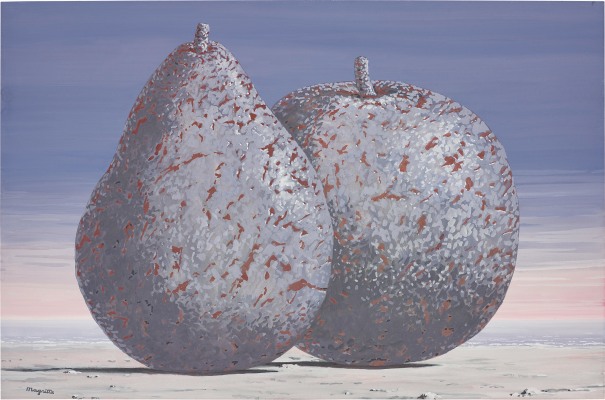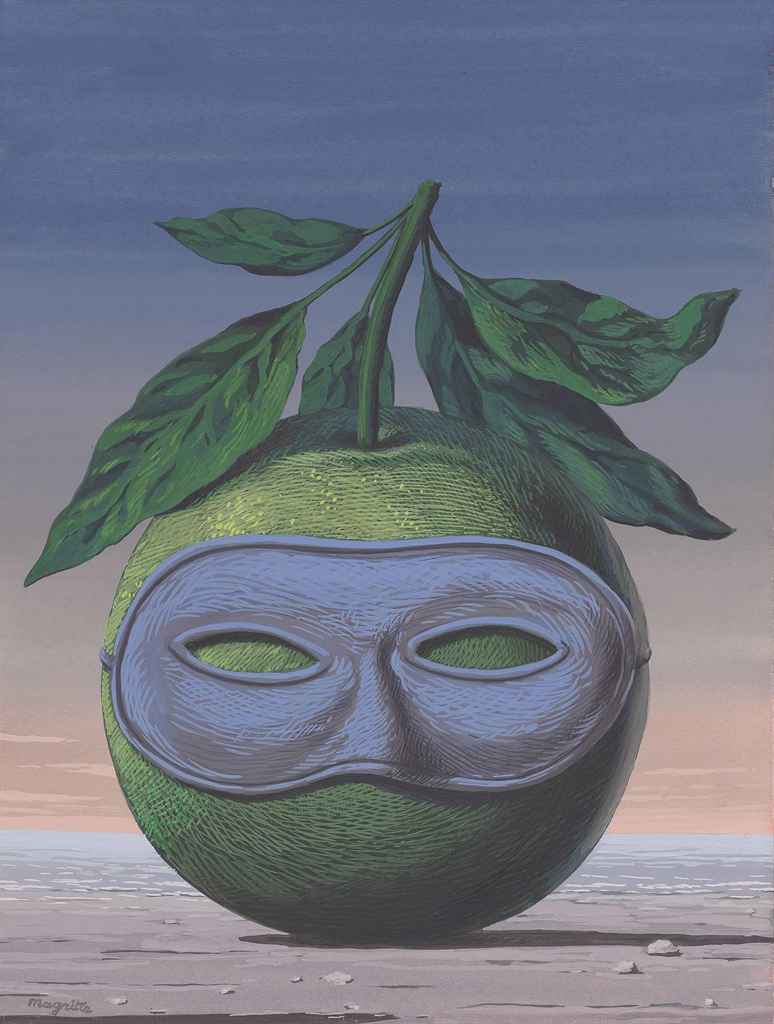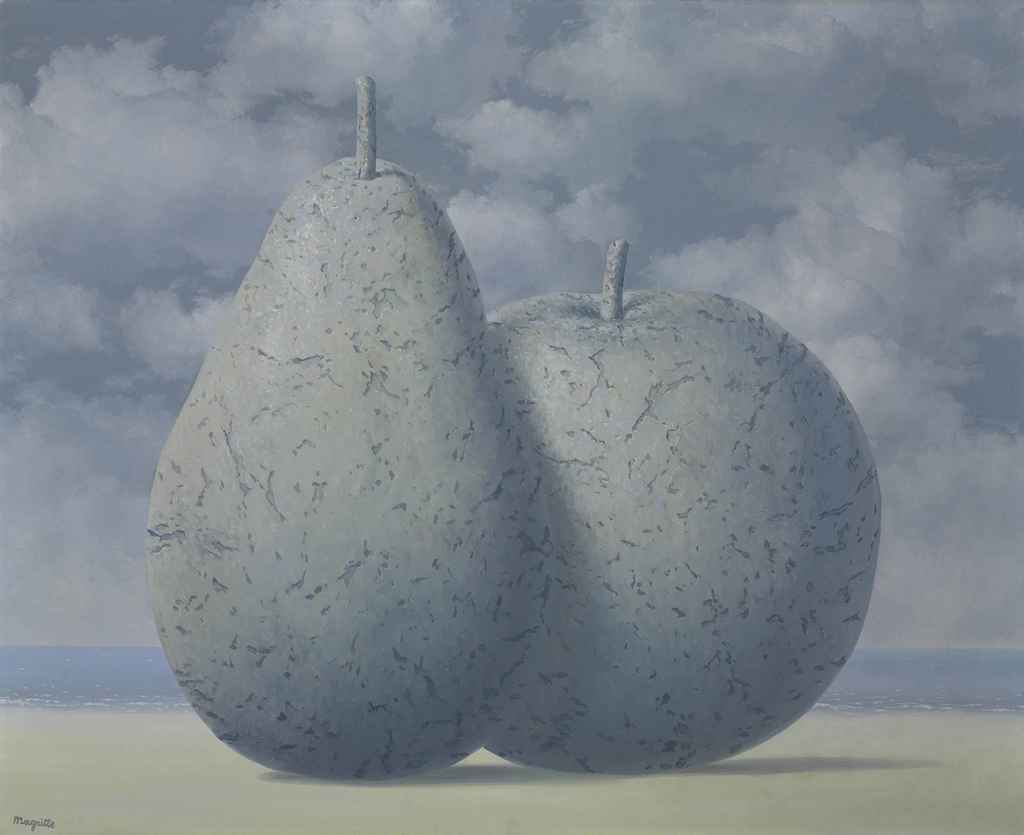RENÉ MAGRITTE Belgium 1898-1967 La Grande Table Signed Magritte. Gouache on paper, 36 x 55 cm. Executed around 1962 . PROVENANCE IngaBritt and Arne Lundberg, Gothenburg, Sweden . Certificate from the Comité Magritte included. . . René Magritte was more interested in the concealed than in the obvious, and in his paintings he often unites disparate objects in unexpected compositions which, taken together, create their own hyper-reality. Magritte was the surrealist who created some of the most iconic works of the twentieth century. . The powerful psychological presence in his enigmatic compositions have been used to visualise some of the deepest feelings and dreams of humanity. In several of Magritte's works, the figure's face is hidden behind an object placed in front of it: an apple, a bird or thin fabric, for example. Many people believe this is linked to his mother's suicide. Magritte was just 13 years old when she was found drowned, and he later recalled that her face was covered by her dress. . A consistent trait in Magritte's paintings is the way in which he positions realistically represented objects in completely unexpected situations, unfamiliar to the observer. One of the surrealist techniques was to shake up the observer's perception of reality through paradoxes, and by providing a subtle hint of eroticism. His work The Loversfrom 1928 shows a pair of lovers in a dimly lit room. Their heads are wrapped in fabric and their tongues cannot pass through the oppressive dry material in their attempt to meet in a kiss. In this work, he has captured the essence of sexual frustration in a masterful manner. . His predominant role model was the pre-surrealist work of Giorgio de Chirico This artist's magical realism, and his way of combining the unexpected in his paintings inspired Magritte, who decided to make each painting a visual poem. He drew his titles from poetry, literature, film or music, and often invited authors such as Paul Nougé and Louis Scutenaire to his home to name finished works. While the titles of his early works featured logical links, they gradually became more independent, occasionally having only the loosest of associations with the paintings. . Magritte was quick to join the circle of artists around André Breton - the founder of The Surrealist Manifesto- and he was actively involved in the group in the period 1927-30. He completed his first surrealist work, Le Jockey Perdu (The Lost Jockey), in 1926. The motif became one of his firm favourites, and he created multiple versions of it. With this motif, he had found a way to create a poetic association by juxtaposing familiar objects in a new context. The displacements of scale reinforce the psychological concentration. "Our secret desire," wrote Magritte, "is for change in the order of things." Disrupting the established order helps the senses break away from ingrained patterns of thought and stimulates our secret feelings. However, Magritte had an ambivalent attitude to the psychoanalysis that was accorded a predominant role in the bearing philosophy of surrealism. He also opposed the doctrinal control of the surrealist movement, and finally broke with André Breton even though he did continue to participate in the Belgian surrealist faction. . La Grande Table (The Great Table) is an extension of his petrified motif, which he began to use in the late 1940s and 1950s. He painted petrified buildings and human bodies, sometimes only semi-petrified. He occasionally presented entire landscapes turned to stone, but in this work only an apple and a pear have been affected. The paradox in the picture disrupts common experience of the nature of the fruit as juicy, tasty and aromatic. The collective symbolism surrounding the fruit - associations with knowledge, eroticism and fertility, for example - is disturbed by the unexpected material. Instead, the painting stimulates new thought associations to concepts such as devotion, inevitability or stability; stone as
RENÉ MAGRITTE Belgium 1898-1967 La Grande Table Signed Magritte. Gouache on paper, 36 x 55 cm. Executed around 1962 . PROVENANCE IngaBritt and Arne Lundberg, Gothenburg, Sweden . Certificate from the Comité Magritte included. . . René Magritte was more interested in the concealed than in the obvious, and in his paintings he often unites disparate objects in unexpected compositions which, taken together, create their own hyper-reality. Magritte was the surrealist who created some of the most iconic works of the twentieth century. . The powerful psychological presence in his enigmatic compositions have been used to visualise some of the deepest feelings and dreams of humanity. In several of Magritte's works, the figure's face is hidden behind an object placed in front of it: an apple, a bird or thin fabric, for example. Many people believe this is linked to his mother's suicide. Magritte was just 13 years old when she was found drowned, and he later recalled that her face was covered by her dress. . A consistent trait in Magritte's paintings is the way in which he positions realistically represented objects in completely unexpected situations, unfamiliar to the observer. One of the surrealist techniques was to shake up the observer's perception of reality through paradoxes, and by providing a subtle hint of eroticism. His work The Loversfrom 1928 shows a pair of lovers in a dimly lit room. Their heads are wrapped in fabric and their tongues cannot pass through the oppressive dry material in their attempt to meet in a kiss. In this work, he has captured the essence of sexual frustration in a masterful manner. . His predominant role model was the pre-surrealist work of Giorgio de Chirico This artist's magical realism, and his way of combining the unexpected in his paintings inspired Magritte, who decided to make each painting a visual poem. He drew his titles from poetry, literature, film or music, and often invited authors such as Paul Nougé and Louis Scutenaire to his home to name finished works. While the titles of his early works featured logical links, they gradually became more independent, occasionally having only the loosest of associations with the paintings. . Magritte was quick to join the circle of artists around André Breton - the founder of The Surrealist Manifesto- and he was actively involved in the group in the period 1927-30. He completed his first surrealist work, Le Jockey Perdu (The Lost Jockey), in 1926. The motif became one of his firm favourites, and he created multiple versions of it. With this motif, he had found a way to create a poetic association by juxtaposing familiar objects in a new context. The displacements of scale reinforce the psychological concentration. "Our secret desire," wrote Magritte, "is for change in the order of things." Disrupting the established order helps the senses break away from ingrained patterns of thought and stimulates our secret feelings. However, Magritte had an ambivalent attitude to the psychoanalysis that was accorded a predominant role in the bearing philosophy of surrealism. He also opposed the doctrinal control of the surrealist movement, and finally broke with André Breton even though he did continue to participate in the Belgian surrealist faction. . La Grande Table (The Great Table) is an extension of his petrified motif, which he began to use in the late 1940s and 1950s. He painted petrified buildings and human bodies, sometimes only semi-petrified. He occasionally presented entire landscapes turned to stone, but in this work only an apple and a pear have been affected. The paradox in the picture disrupts common experience of the nature of the fruit as juicy, tasty and aromatic. The collective symbolism surrounding the fruit - associations with knowledge, eroticism and fertility, for example - is disturbed by the unexpected material. Instead, the painting stimulates new thought associations to concepts such as devotion, inevitability or stability; stone as
.jpg)
.jpg)



.jpg)








Testen Sie LotSearch und seine Premium-Features 7 Tage - ohne Kosten!
Lassen Sie sich automatisch über neue Objekte in kommenden Auktionen benachrichtigen.
Suchauftrag anlegen